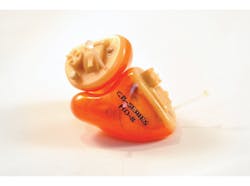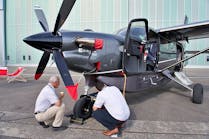Aviation: a Career Prescription for Hearing Loss?
It is no secret that certain activities are tough on your ears. Shooting and much of military life, construction – we would expect hearing losses. But dentistry and aviation? Oh, yes.
The National Institute of Deafness notes that over 36 million Americans have hearing loss, and loud or continuous noise, such as that encountered in the above professions, has a cumulative destructive effect on hearing. That word “cumulative” is key. Long exposure to a nearby dentist’s drill, or years of working around airplanes – even at some distance – can add up to a number of “pardon me” moments.
Passive hearing protection, like ear plugs, is a cheap and effective guard against job-related hearing loss. But what if you already don’t hear well; or what if you need to hear what’s going on around you while you work? Earplugs just blot out all sound.
An old-style hearing aid amplifies sounds. That’s good, for use in quiet environments; but it is not handy if the environment is loud. What is needed is a device that amplifies sound, when the area is quiet, and also blocks loud sounds, to protect hearing.
There is a device that does this. It’s called a digital “tactical” hearing enhancement device. Like a pilot’s active headset, it instantly blocks loud noises; the rest of the time, it enhances sounds, in the frequencies where hearing has been damaged.
Such tactical devices fit deep in the ear canal, where they can block sounds most-effectively, and where they also use the ear’s full structure to gather sound before amplification. They’re practically invisible, and are individually fitted, for effectiveness and for comfort.
These tiny in-the-ear units boost sound in the specific frequency bands where it is needed, and the weak ear’s reception can often be raised to the level of the better ear’s, returning pleasant, comprehensible, directional hearing – the kind we started life with.
When this technology was first demonstrated a quarter-century ago, the processing and signaling equipment was the size of a washing machine. By the mid-1990s, the technology had shrunk enough to fit in a pod behind the ear, making the first modern digital hearing aid, practical.
Today, the units fit literally into the ear, sitting lightly and nearly invisibly, using very little power (and thus requiring only infrequent replacement of extremely small batteries).
Tactical Hearing, a master fitter and distributor, is currently in Hangar C at Sun ‘n Fun, where trained staff can perform a hearing-loss test. If you’re a candidate for this technology, they can take molds of your ears, too.
Among several models they offer may be the one that does you the most good. A pair of the best devices available can cost anywhere from $4000 – on down.
Come to their booth, look, ask questions; and if you’re so inclined, get a quick, no-cost hearing test; or order your own custom-fit, sound-balancing, tactical, digital hearing solution.
For more information: www.tacticalhearing.com


